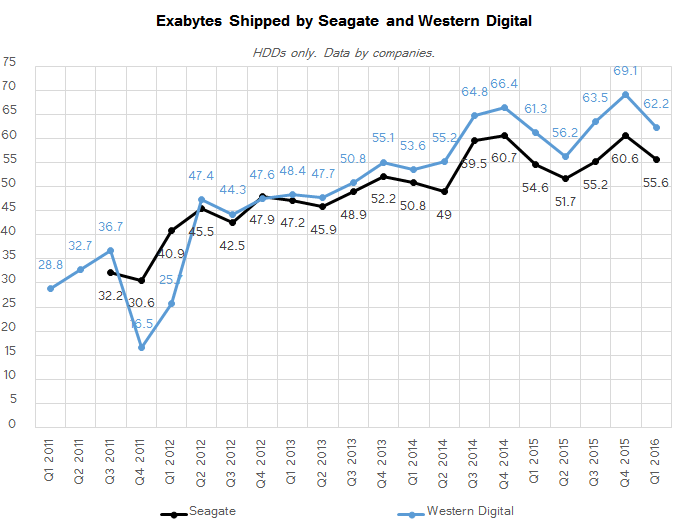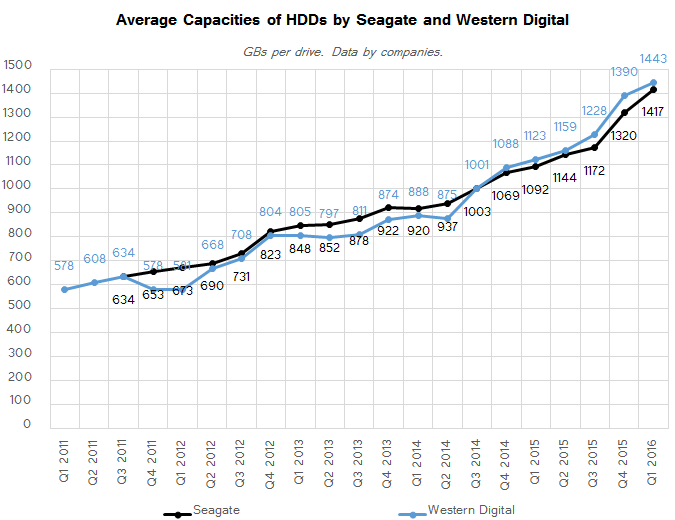Market Views: HDD Shipments Down 20% in Q1 2016, Hit Multi-Year Low
by Anton Shilov on May 12, 2016 8:00 AM ESTAverage HDD Capacities Continue to Increase
Despite the drop in HDD unit shipments, both sequentially and year-over-year, total capacities shipped by the two leading makers of hard drives increased in Q1. Seagate supplied 55.6 EB (Exabyte) of HDD storage last quarter, up from 54.6 EB in Q1 2015, but down from 60.6 EB in the previous quarter. The total capacity of Western Digital’s HDDs shipped in the first quarter of 2016 was approximately 62.2 EB, a moderate increase from 61.3 EB in Q1 2015.
When it comes to hard drives, one thing that has been growing quarter-over-quarter for a long time now is average HDD capacity, particularly in the enterprise segment, but not only there. In Q1 2016, an average drive could store around 1.4 TB of data, an increase of 28.5% (Western Digital) and 29.7% (Seagate) from the same quarter last year.
Average HDD Price Stays at $60 compared to Q1 2015
Despite the local price hikes by HDD makers, the industry can clearly produce more hard drives than it can consume, which is why prices of mass HDD models remain rather low. This will likely change in the future, when consumers shift to higher-capacity drives because of 4K UHD video or other reasons, but right now an average HDD from either Seagate of Western Digital costs approximately $60.
This will likely change after Seagate implements its plans to cut down its manufacturing capacities and supply-demand balance of the market will stabilize. However, it remains to be seen how significantly that is going to change going forward.













116 Comments
View All Comments
Wolfpup - Thursday, July 14, 2016 - link
No it isn't. 1TB is nothing if you're having to pull in this kind of data. Hell, a lot of new games are about 50GB a piece now.seerak - Monday, May 16, 2016 - link
Or screwups like this onehttp://www.snopes.com/apple-music-deleting-files/
Wolfpup - Thursday, July 14, 2016 - link
Yeah, Comcast is rolling their caps out wider starting NEXT MONTH. They're the largest ISP, so....will792 - Thursday, May 12, 2016 - link
I have numerous friends with rapidly growing repository of video and image files (NEF files for Nikon D800 are 30-35MB each). Hard drives are the only realistic option to store multi terabyte libraries of created content that is typically mirrored and backed up. Proliferation of video created with GoPro or other action video cameras (including drone mounted cameras) will force consumers to buy hard drives since upload speed of typical Internet connection is too slow for upload of high resolution video content.Murloc - Thursday, May 12, 2016 - link
at the end of the day, not a high % of people do that kind of stuff even though it's gotten more popular over the year.Just about everybody I know owns a laptop. If those increasingly come without HDDs but with SSDs, that's gone, RAW photographers or not.
DanNeely - Thursday, May 12, 2016 - link
In the medium term I wouldn't be concerned about disks for photography (or other bulk storage). The 3.5" HDDs best suited for USB drives/NASes are most similar to enterprise nearline storage drives; which as a segment dominated by cost/gb should be the most resilient part of the HDD market. Until/unless flash becomes cheaper per GB they're unlikely to go away.The short term situation of bottom end consumer drives being in freefall doesn't really matter beyond headline sales figures. The margin on those drives is near zero, so losing them doesn't affect the bottom line much (and that primarily from one time costs related to scaling down production capacity).
I wouldn't worry until sales for 10/15k SAS drives start plummeting as well. They have the highest margins and fund an out-sized share of the R&D needed to develop higher capacity drives. When that goes away we'll either see a significant slowdown in capacity growth or rise in prices to sustain R&D spending (or both). That will probably be the beginning of the end for HDDs by making it much easier for flash to catch up in price/GB.
tamalero - Tuesday, May 17, 2016 - link
arent 10k 15k sas drives being replaced by SSDs in the corporate level?FunBunny2 - Thursday, May 12, 2016 - link
yeah. what drove the first PC period was Word/Office at home, likely pirated from work. no one has ever had much need for more than 640K until the recent gaming fiasco. windoze bloated up, which drove it, too. but that has ended. we're now in the Times of Good Enough.Michael Bay - Thursday, May 12, 2016 - link
>gaming fiasco>windoze
Don`t forget to take your meds, please.
Wolfpup - Thursday, July 14, 2016 - link
<<< no one has ever had much need for more than 640K>>>(!) Uh... Are you in the right decade?
And what's a "gaming fiasco"?